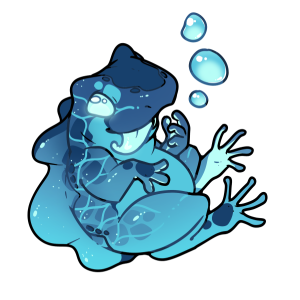 Hoppopper Hoppus poppus
Hoppopper Hoppus poppus
Pets

APPEARANCE
Sizewise, Hoppoppers generally fit comfortably in the palm of most adult Dextroluma. Blue aqueous Hoppoppers are the most abundant type, however, Hoppoppers come in a number of different appearances, some of which seem to be influenced by seasons or even by strange magics. To see the currently available different types of Hoppoppers, please visit the Encyclopedia.
HABITAT
Most Hoppoppers tend to dwell in small lakes, ponds and caves when found in the wild, and are commonly found in every nation on Aerius' surface, often with adaptations to account for their environment. While they are typically semi-aquatic, they do not require large tanks of water and are typically content with just a bowl that they can splash in when desired. They do require little 'hides' of plants or hollowed out rocks that they can lurk in within their cage or tank.
Behaviors
Hoppoppers make trilling noises that are relatively comparable to those of an Earth frog, but are typically higher pitched. They spend much of their time hiding in some fashion, either in rock/plant 'hides' or within water (or, in the case of one variety of Hoppoppers native to the Obsidian Peaks, lava). When not hiding, they do enjoy receiving pets, and the enrichment of live insects to hunt. They can be trained to perform tricks if desired, depending on the intelligence of the specific Hopopper.
DIET
Hoppoppers eat a large variety of insects both native to Aerius and those unintentionally or intentionally brought there by other species, including Earth insects. They will also eat small molluscs if the chance arises.
ROLES
Hoppoppers catch and eat all sorts of insects across Aerius, and are sometimes kept as working animals to keep gardens and households insect free, as pesticides and insect sprays are not typically allowed on Aerius.
REPRODUCTION
Egg.
LIFESPAN
Due to the effects of magic, Hoppoppers owned by another species will live for as long as their owner does. A wild Hopopper will typically live between three to ten years.
CORRUPTION
For unknown reasons, Hoppoppers seem to have a natural defense against necrosis, although some varieties native to the Blighted Wilds seem to have evolved to cope with the disease. The species overall is heavily studied due to both this and the ease of obtaining numerous quantities of them for use in research studies.

